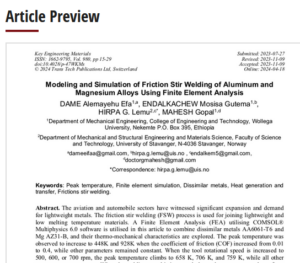Abstract
Utilizing more than one cutting tool to machine a work piece is parallel turning. But due to interaction of parallel tools at a same time an additional settings are needed to escalate the stability of the machine and tool. The current study utilizes a supplementary cutting tool, placed near to the cutting tool by using special modeled jigs. The influence of cutting parameters on surface roughness was investigated in this study utilizing AISI 1050-steel as the work piece and coated carbide cutting tools under dry machining circumstances. Surface roughness profilometer were used to assess surface roughness quality. The cutting parameters are optimized by using Taguchi L9 orthogonal array design of experiments and ANOVA. The MINITAB 17 software is used to solve the regression coefficient. The result indicates, cutting speed was the most notable surface roughness metric, followed by feed under dry circumstances. The percentage of contributions is 71.09 and 19.81% under dry turning conditions. The best surface quality achieved with optimal cutting parameters was 1.05 µm.
Authors
Dereje Gemechu Bedane
Endalkachew Mosisa, Wollega University
Mahesh Gopel, Wollega University
Read a full article here.



